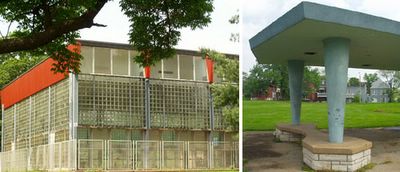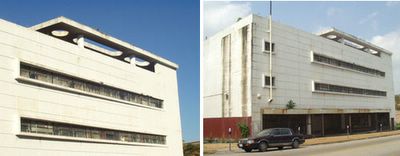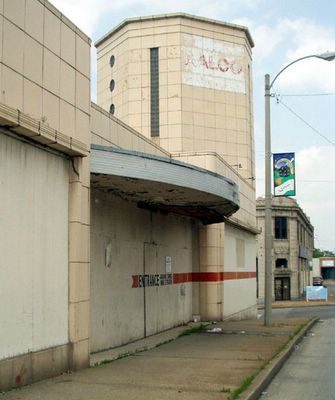
Martin Luther King Dr. & North Kinshighway
St. Louis has racial divide in its DNA, and the history of St. Louis County is also the tale of White Flight. After WW2, the new world of tomorrow sprang up, and the architecture was as modern and adventurous as the future promised to be. On both sides of the city/county line, sleek samples of progress ushered folks into the suburban frontier, and all our inner-ring suburbs – especially on the north side – retain amazing examples of that promise because they were abandoned soon after they were built by Whites leapfrogging over Blacks on their way to deep county. Wellston is a perfect example of progress-to-stagnation Caucasian-Modern architecture.
Start with this excellent site, then motor west on Martin Luther King Dr. from downtown. In the mid-1950s, Sherman Park was given some future polish with googie pavillions for the sports field and the Wohl Community Center moved from across the street and into the park proper. The center still features an indoor pool wing, with sliding glass doors at ground level to let in fresh air, and massive expanses of glass block above that. In person, it’s an overwhelming sight.

Martin Luther King Dr. between Hamilton & Hodiamont
Right before the county line at Hodiamont is the remains of the JC Penney’s, which closed around 1975. My father was a glazier, and remembers installing mirrors in the building in 1950, and at that time it was still an old-fashioned department store. So, the “Le Corbu” facade was tacked on sometime in the mid-1950s, at the height of the Wellston Shopping District’s popularity.
This building is still space-age triumphant in its decay, and while photographing it in 2003, I talked with a man who claimed to own it. He said the building was still in good condition, with only minor water damage on the top floor, and he’d like to turn it into a black history museum.

Evergreen & Martin Luther King Dr.
Another case of an old building getting a post-war face lift, in this case a streamlined deco in the late 1940s. This was the first Central Hardware in the county, just a block and a half past the city line. Its last incarnation was as Aalco Plumbing Supply.

Kienlen & Martin Luther King
Right as Skinker becomes Kienlen and city becomes county, banking becomes dramatic.
The advertising tower was there when it was tiny, old-fashioned Sky Bank. In the early 1950s, a brown and black granite facade was added to the (then) Easton side and it became State Bank. Automobiles strangled the street cars, so the glorious turquoise tile drive-thru addition was added in the early 1960s.
I was so smitten with the car-culture aqua-ness of it all, that I didn’t notice the sophisticated geometry of the addition until I shot it in black & white. I adore this building, and it’s at the point where the security guards (it’s now a Regions Bank) ignore me as I document every fine detail of the defunct drive-thru aisles.
And I document this because I know it will all come down. New buildings have been slowly going up around the Wellston Hub, and there is a grand plan. Historic preservation being what it currently is, if any saving gets done, it will be only of buildings retaining any of their pre-WW1 architecture. But this entire district was all about progress and commerce, and the old buildings sporting their mid-century makeovers say more about our former aspirations and dreams than any old wives tales a This Old House rehab would spin. I think it’s important to tell all of the story, and Wellston is a particularly juicy chapter.

I grew up at 5943 Theodosia. I rode the streetcar to Soldan High school. And visited Ellerbrock baker daily that was right behind the White Mill, where I used to play records on the juke box and get hamburgers and fries! Katz Drug store was the tallest building I knew. We lived right behind the shopping area. Went to the Victory Theater, ate at Woolworths and got furniture from Biederman’s (some of which I still have). Yes, I remember it well. Shopping at Kresge’s and Jupiter stores. And boy, do I have memories!!
I used to deliver the Post-Dispatch newspaper in Wellston and the surrounding area in the mid to late 60s as a boy.
I am white and never had any problems it was fairly integrated then and on Saturdays it was sort of a shopping hub.
My parents banked at the State Bank.
Anyone remember the Olympic Drive-In just outside of Wellston on what was St.Charles Rock Road. It was an adult drive-in so they put up black parachutes on telephone poles to keep people from “peaking” at the movies.
There used to be a Harley M/C shop across the street and an Ontario Store which was like a Wal-Mart Super Center…..ahead of it’s time.
We lived close by in the neighborhood behind the Ontario Store.
Seeing your site brings the memories flooding back.
Thanks!!!!
I came in late on this one, but I feel like I grew up in Wellston.
My Dad held a high position at State Bank, and my brothers and I wreaked havoc there every Saturday morning as Dad went in for his sixth day of work for any given week–it was the 50s. Good times to be in Wellston. I remember sliding along the terrazzo floors of the bank like it was a skating rink. And the air conditioning was COLD! Average car payment during that era was below $50/month.
What makes a building architecturally significant vs. sentimentally valuable?
If you tried to tear down the Arch (let’s face it, using today’s standards, the area could be reclassified as blighted; it’s only a mile or so from East St. Louis), you’d have a fight on your hands. But, all over the city, buildings are allowed to fall into disrepair and ultimately meet the wrecking ball despite their close architectural relationship to said stainless monster. Why?
Don’t get me wrong, I am a big fan of the Arch. But, I’m also a fan of many of the architectural advances of that era. What makes one more significant than another. Please tell me that size isn’t the only thing that matters. 😉
What appears to happen, at least to me, the somewhat uninitiated, is that each generation has a subset interested in preserving the buildings of its childhood (and maybe one generation before). These individuals make it their life’s work to champion the cause of the structures they hold in high regard. They create vast and complicated codes and standards to describe exactly what should and shouldn’t be included and excluded, though my hunch is that the code is still inextricably tied to their opinion about meaning more than an objective standard. Could be wrong. But…
Since most of the rest of us don’t have the time or interest to navigate such treacherous rhetoric and code, so we accept the preservationist’s claims to the position of authority on the matter. And, we divide off into camps in favor or against usually in no relationship to our actual feelings about architecture. Why?
At the end of most days, there are two kinds of people: people who are more interested in money and people who are less interested in money. People interested in money can always find a reason to tear down even the most highly prized building (at least that’s what we think from our side). People less interested in money can always find a reason to preserve even the most useless structure (at least that’s what they think from their side).
Too bad the debate isn’t over architectural value. We’d probably all agree if that were the case.
The preservationists have learned to make the debate about sentiment because it’s the only thing they can use to directly tie the preservation to potential profit. Without that sentimental tie, their effort to preserve buildings of objectively-determined significance would fail.
So, Toby, it would appear that the reason your favorite mall was torn down was not because it wasn’t of any architectural significance. It was because no one could find a way to convince a larger segment of the population that it had any sentimental value. Not to say that you were alone in your love for it, but the connection wasn’t as strong for everyone else.
That being said, it’s no surprise that the architecture of Wellston will eventually be lost, no matter what era of construction we are generationally-disposed to protect. The memory of how badly we humans behaved is unfortunately impossible to ignore every time we even hear the name, Wellston.